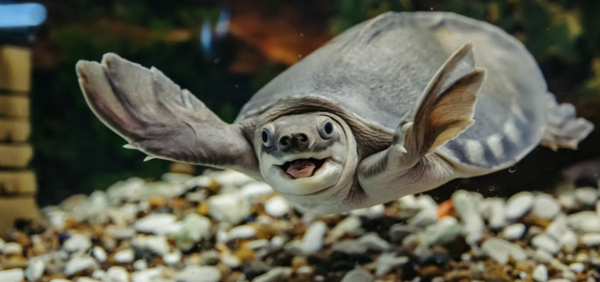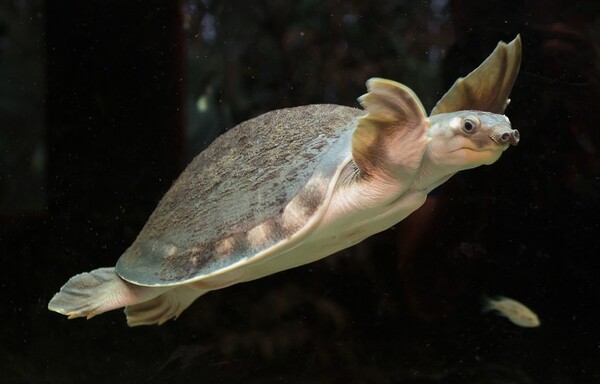If you're curious about the pig-nosed turtle lifespan, pig-nosed turtle (Carettochelys insculpta), also known as the Fly River turtle, the pitted-shelled turtle, and the Warrajan 。you're not alone. These unique creatures, native to northern Australia and southern New Guinea, are fascinating for their pig-like snouts and remarkable adaptability. Whether you're a prospective pet owner, an enthusiast of reptiles, or just someone interested in learning more about this species, understanding how long a pig-nosed turtle lives is crucial to appreciating its care requirements, conservation status, and behavior.

In this article, we'll cover everything you need to know about the pig-nosed turtle lifespan, from the factors that influence their age to the steps you can take to ensure a long and healthy life for these amazing animals.
One of the most common questions people ask is, "How long does a pig-nosed turtle live in the wild?" In its natural habitat, the pig-nosed turtle can live for up to 50 years or more. However, their exact lifespan in the wild is influenced by various environmental factors, including food availability, water quality, predation, and habitat destruction.
Natural Threats: The pig-nosed turtle faces several threats in the wild, including predation by larger animals, such as crocodiles, and human activity like hunting and habitat degradation. Despite these risks, they have evolved to be relatively resilient and can live for several decades if their environment is stable.
Habitat Importance: The pig-nosed turtle lives in freshwater rivers and streams, typically in tropical areas. Clean water and abundant food sources are key to their long lifespan, making environmental protection essential for preserving their populations.
In captivity, pig-nosed turtles can live just as long as in the wild, if not longer. When kept in a controlled environment, such as a properly maintained aquarium or pond, their lifespan can be extended, sometimes reaching up to 60 years or more. However, to achieve this, there are several important considerations that must be taken into account.
Water Quality and Diet: The right water conditions—especially pH, temperature, and cleanliness—are essential for their health. Captive pig-nosed turtles require a well-maintained filtration system and a balanced diet that mimics their natural food sources, such as fruits, aquatic plants, and small invertebrates.
Space and Socialization: A spacious tank or pond is vital for the turtle’s physical and psychological well-being. Pig-nosed turtles are social creatures and benefit from a larger area that allows them to swim freely, dive, and rest. A proper habitat reduces stress and supports a longer life.
When considering the pig-nosed turtle lifespan, it’s important to understand the various factors that can influence how long these turtles live, both in the wild and in captivity.
Diet and Nutrition: The pig-nosed turtle thrives on a varied diet that includes fruits, vegetables, and aquatic invertebrates. A well-balanced diet plays a significant role in maintaining their overall health and longevity.
Environmental Conditions: Both temperature and water quality are crucial. Extreme temperatures or polluted water can lead to stress, disease, and a shortened lifespan. Clean, warm water with a stable temperature between 75°F and 85°F (24°C-29°C) is ideal.
Predation and Threats: In the wild, pig-nosed turtles face predators like crocodiles and large fish. While captivity offers some protection, they can still be vulnerable to diseases or improper care. Overcrowding in captivity, poor filtration, and improper food can drastically shorten their lifespan.
Genetics: Like all animals, genetics also play a role in how long a pig-nosed turtle can live. Healthy genetic lines are more likely to result in longer-lived individuals, while poor breeding practices could result in health problems that affect lifespan.
The pig-nosed turtle is considered vulnerable by the International Union for Conservation of Nature (IUCN), and its lifespan in the wild can be significantly threatened by environmental changes and human activities. Understanding their endangered status is key to helping ensure their survival in the wild.
Threats to Their Survival: Habitat destruction, illegal hunting, and the pollution of rivers and freshwater systems pose major threats to the survival of pig-nosed turtles. Climate change is also expected to alter their environment, which could negatively impact their longevity and reproduction rates.
Conservation Efforts: Efforts to protect the pig-nosed turtle include habitat restoration, legal protections, and public education about the importance of preserving freshwater ecosystems. In captivity, breeding programs are underway to help increase their numbers and eventually reintroduce them into the wild.
If you're considering adopting a pig-nosed turtle as a pet, it’s essential to know how to care for them properly. With the right care, they can live a long, healthy life, whether in a pond or an aquarium.
Proper Tank Setup: Make sure the tank or pond has adequate space, a filtration system, and access to natural light. Turtles need both shallow and deep areas where they can bask and swim. A well-maintained tank will provide them with the necessary environment for a long lifespan.
Temperature and pH: As mentioned earlier, maintaining the right water temperature (75°F - 85°F or 24°C - 29°C) and pH (around 7.5 to 8.5) is crucial for their well-being. Regular water testing and maintaining the ideal conditions will help ensure they live a long life.
Feeding and Nutrition: Provide a balanced diet of aquatic plants, fruits, and invertebrates. Feeding them a varied diet rich in vitamins and minerals is key to keeping them healthy and ensuring they reach their full lifespan.
When compared to other species of turtles, the pig-nosed turtle has a relatively long lifespan, often surpassing the lifespan of common pet turtles like box turtles or red-eared sliders. For example:
Box Turtles: Typically live 50-70 years in the wild, but their lifespan can be shorter in captivity due to poor care.
Red-Eared Sliders: Known for being popular pets, these turtles can live around 20-30 years in captivity with proper care.
Pig-Nosed Turtles: The pig-nosed turtle’s ability to live up to 50-60 years in captivity and sometimes longer in the wild places them among the longer-living freshwater turtles.
Understanding how long a pig-nosed turtle lives is just one part of what you need to know if you're interested in these incredible creatures. Their lifespan is influenced by a combination of genetics, diet, environmental factors, and conservation efforts. Whether in the wild or in captivity, pig-nosed turtles have the potential to live for several decades, making them a long-term commitment for those interested in caring for them.
If you're planning to adopt one, remember that proper care—including diet, water quality, and the right habitat—is essential for ensuring a long, healthy life. Moreover, supporting conservation efforts helps protect these unique animals in their natural habitats, ensuring that future generations can also enjoy the beauty of the pig-nosed turtle.

Yes, pig-nosed turtles (Carettochelys insculpta) are considered rare and are classified as vulnerable by the International Union for Conservation of Nature (IUCN). Their populations are at risk due to habitat destruction, illegal trade, and pollution in their native regions, which are primarily freshwater rivers in northern Australia and southern New Guinea. As their habitats continue to shrink, their numbers are decreasing, making them rare in the wild. Conservation efforts are ongoing to protect their habitats and ensure their survival.
Pig-nosed turtles (Carettochelys insculpta) are air-breathing reptiles, like most other turtles. They breathe through their lungs, and they must surface regularly to inhale oxygen. The exact time they can stay submerged underwater depends on factors like activity level, water temperature, and oxygen availability. However, in general:
Normal Breathing Time: A healthy pig-nosed turtle can hold its breath for 10-20 minutes while diving or swimming underwater. This duration may vary based on the turtle's activity level and environmental conditions. For example, if the turtle is resting or swimming leisurely, it may stay submerged for longer periods.
Longer Submersion: In cooler water, or if the turtle is at rest, it can hold its breath longer—sometimes up to 30 minutes. However, if the turtle is actively swimming or foraging for food, it typically surfaces more frequently to breathe.
Basking: Pig-nosed turtles also bask at the water’s surface to regulate their body temperature and breathe in air. Basking is an important behavior that helps them maintain optimal respiratory function and metabolic processes.
Pig-nosed turtles, like other aquatic turtles, are well-adapted to their environment. They have efficient oxygen storage capabilities, meaning they can take in large amounts of oxygen at once and use it over extended periods while submerged. Additionally, their slower metabolism when they are at rest allows them to conserve energy and oxygen, enabling them to stay underwater for longer durations without needing to surface for air.
In conclusion, while pig-nosed turtles typically stay submerged for around 10-20 minutes during normal activity, they can hold their breath for longer, up to 30 minutes, under the right conditions.
The price of a pig-nosed turtle can vary depending on several factors, such as its size, age, and the seller. On average, you can expect to pay anywhere from $500 to $1,500 USD for a pig-nosed turtle in the pet trade, though some sellers may charge more. It's important to note that the pig-nosed turtle is a protected species, and buying one from the wild or through illegal channels can be harmful to both the turtle and the ecosystem. Always ensure that any turtle you purchase is legally and ethically sourced, preferably from breeders who follow proper regulations.
Here are some fun facts about the pig-nosed turtle that make them unique and fascinating creatures:
Distinct Snout: The pig-nosed turtle is named for its unusual pig-like snout. This snout helps the turtle breathe and navigate through water, and it gives them a unique appearance compared to other turtles.
Excellent Swimmers: Unlike many other turtle species, pig-nosed turtles are strong swimmers and spend much of their time in the water. They have webbed feet and are capable of diving deep underwater, using their strong front limbs to paddle.
Basking Behavior: These turtles are known to bask on rocks or logs in the sun to regulate their body temperature. They enjoy soaking in warmth after being submerged in cooler waters.
Freshwater Adaptation: Unlike most sea turtles, pig-nosed turtles are freshwater species and prefer slow-moving rivers and streams. Their habitats are usually tropical, with clean and clear water, where they can find abundant food.
Long Lifespan: As mentioned earlier, pig-nosed turtles can live for up to 50 years or more in the wild and can sometimes live even longer in captivity under proper care, making them a long-term commitment for pet owners.
Unique Shell: Their shell is somewhat different from other turtle species. It is relatively flat and smooth, helping them to move efficiently through the water, and it has a light coloration, often tan or brown with darker markings.
Dietary Habits: They are omnivores, meaning they eat both plants and animals. They feed on aquatic plants, fruits, and small invertebrates, such as insects, crustaceans, and mollusks.
Protected Species: Due to their vulnerable status, pig-nosed turtles are protected by conservation laws in Australia and New Guinea. This makes their populations more restricted, and conservation programs are working to protect them from poaching and habitat loss.
These fascinating turtles are not only rare but also uniquely adapted to their environment, making them one of the most intriguing freshwater species in the world.
animal tags: pig-nosed-turtles
We created this article in conjunction with AI technology, then made sure it was fact-checked and edited by a Animals Top editor.